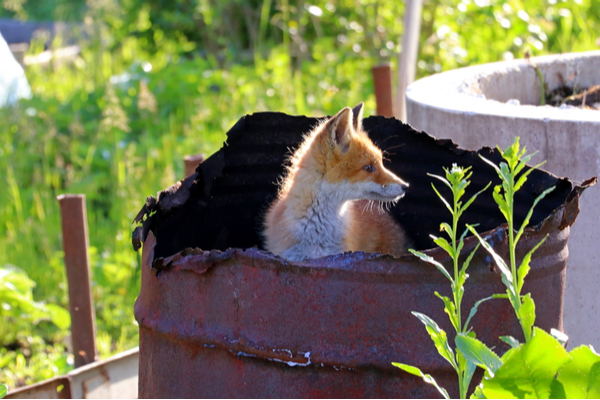Foxes are medium-sized, omnivorous mammals in the same Canidae family as dogs. They are highly-adaptable mammals capable of living in a wide range of rural, suburban, and urban environments. As opportunistic scavengers, they’ll eat nearly anything. They often approach homes at night to steal from the garbage.
Foxes are rarely dangerous, but they can be distressing, troublesome, and destructive when they’re on your property. Like most wildlife, foxes are opportunistic. They’re looking for easy access to food, shelter, and water. By learning what these opportunists want, you can learn how to keep it away from them. Here’s what you should know about the foxes near you, and how to prevent them:
What are foxes?
Foxes are medium-sized nocturnal, omnivorous mammals in the Canidae (dogs, wolves, coyotes) family. There are twelve species of “true” fox in the genus Vulpes along with another 25 species in the broader fox classification. The most common and recognizable fox in North America is the red fox (vulpes vulpes).
Red foxes are 18 to 34 inches long with 12 to 22 inch long, bushy tails. They weigh about 7 to 15 pounds. Adult red foxes are bigger than most house cats and smaller than most dogs. They have very distinctive orange-red fur, white fur on their underbellies and snouts, and black-tipped ears. Their tails have white tips and a black undercoat of fur. Their paws and legs are also black.
Where do they live?
Foxes are extremely adaptable. Different species live all over the world, on every continent except for Antarctica. Red foxes are the most widely distributed carnivore in the world. They’re found throughout most of North America, Europe, Asia, and Australia, as well as parts of North Africa.
Red foxes live in a wide variety of urban, suburban, and rural environments. As solitary scavengers and hunters, they adapt very well to living near humans. Foxes often live at the edges of forests or brush and sneak closer to neighborhoods at night to steal food. Red foxes live and rear young in dig small burrows with several exits. They dig these burrows near water, usually around natural cover like brush, trees, or other undergrowth.

What do they want?
Foxes roam their home territories looking for food. Red foxes can adapt to virtually any environment so successfully largely because of their omnivorous diet. They'll eat just about anything they can get their paws on. In the wild, they are solitary hunters and foragers. They’ll catch and eat small animals including lizards, voles, bugs, rodents, rabbits, or even worms. When they can’t find meat, they’ll also forage for berries, nuts, seeds, and even leaves.
Foxes are opportunistic foragers, which basically means they’re looking for easy food opportunities. In other words, they’re mostly interested in food they don’t have to work too hard to find. They like to sniff out unsecured garbage because it’s easy to find, abundant, and consistent. Many return to food sources they know they can access habitually, especially as other food sources become scarce. Foxes want to live somewhere with plenty of places to hide and plenty of food to steal easily.
Are they dangerous?
Not usually. Foxes are naturally afraid of people and will almost never behave aggressively. If you encounter a fox, it will likely flee from you before you can get close. If a fox doesn’t seem afraid of you, it may be because a person has fed them. You can scare them away by whistling, making loud noises, or throwing things toward them (don’t hit them!). You are much more likely to be attacked by a dog than by a fox.
There are several circumstances when a fox could be considered dangerous pests, however. Foxes tend to be a problem for farmers, because they will enter hen houses to eat chickens. Although fox attacks on pets are rare, they could potentially prey on small cats. They may be more likely to behave aggressively to defend their den or offspring. Finally, although it’s very rare, a fox could carry and transmit rabies. You should never approach a fox that looks is behaving strangely or appears rabid or sick.
How can you keep them away?
Foxes come near your home or business looking for food that’s easy to steal. If they can’t find food easily, they’ll move on. First, keep all of your trash cans sealed whenever you aren’t using them. Use bungee cords to tie down your dumpster, bin, and can lids. Before throwing garbage in your outdoor bin, make sure you seal it in a plastic bag. Never leave unsealed garbage outside overnight. Clean out your cans, bins, and dumpsters once every few months.
Next, look for places where foxes could hide or sneak around. Foxes are very shy. The more hidden they feel, the more confident they’ll be moving toward your home. Remove brush, tall grass, overgrown shrubs, and other natural sources of cover. Dig some underground fencing beneath your porch, deck, and fencing to prevent them from burrowing under it for cover. Lights, sprinklers, noisemakers, and other deterrents will also help keep foxes from entering your yard.
Foxes aren’t dangerous, but they’re never desirable either. You should never try to domesticate, feed, or otherwise encourage a fox to come to your home. Like most wildlife, they have much more potential to be dangerous when they’re less afraid of humans.
If you have a fox problem on your property, call Varment Guard any time. We can safely, humanely, and effectively remove foxes from your property. We’ll figure out what they wanted and make sure they can’t get it again, too. Next time you see the fox around your house, don’t panic! Just call Varment Guard. We’ll make sure your home stays safe.






